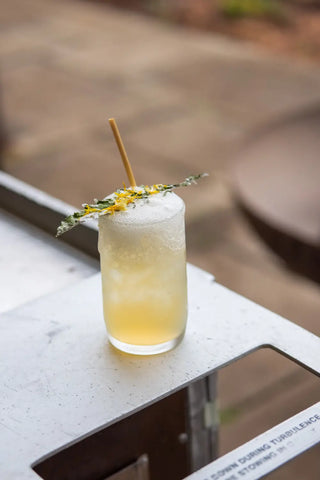"What is a weed? A plant whose virtues have not yet been discovered."
Ralph Waldo Emerson
This plant holds a very special meaning for us at Trolley'd as one of our favourite and most enduring edibles. Not only does it represent the onset of the new season after a period of wintry stillness. Often mistaken for a weed, its' remarkable resilience in the face of this tarnished reputation, makes us love it all the more. Anyone wanting to wage a 'round up' war with our cheerful friend, please think again. This unassuming flower holds the antidote to a long list of ailments and has been used by humans as a food and medicine for much of recorded history.
Dandelion, Taraxacum, is a large genus of flowering plants in the family Asteraceae. They are thought to have evolved about 30 million years ago in Eurasia and fossil seeds of the Taraxacum tanaiticum have been recorded as early as the Pliocene. They have sunk their roots deep in history and are well known in ancient Greek, Egyptian, Roman and Chinese cultures. In Greek mythology, Theseus ate dandelions for 30 days to fortify himself to fight the Minotaur, a half man-half bull that ate the young adults of Athens.
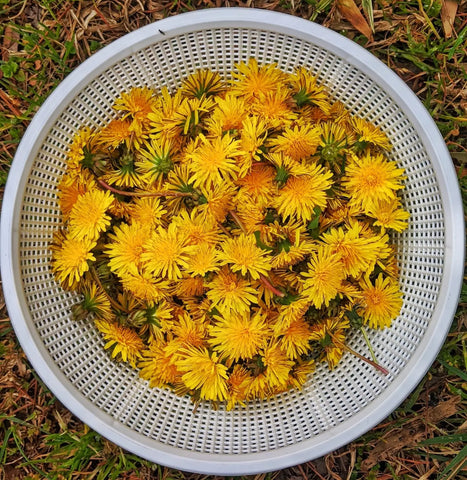
Most of us have fond memories of Dandelions from our childhood - creating a dandelion chain, blowing the clocks or blowballs and making a wish, or being told you would wet the bed if you picked one. Little did many of us know that it’s leaves were a superfood with one cup boasting 535% of our daily potassium requirements and 112% of vitamin A.
The first mention of the Dandelion as a medicine is in the works of the Arabian physicians of the tenth and eleventh centuries, who speak of it as a sort of wild Endive, under the name of Taraxcacon. This highly nutritious plant continues to be revered for a wide array of medicinal properties used to treat a myriad of physical ailments, including cancer, acne, diabetes, toothaches, liver disease, constipation, digestive disorders, to promote urine (diuretic), even warts and dandruff.
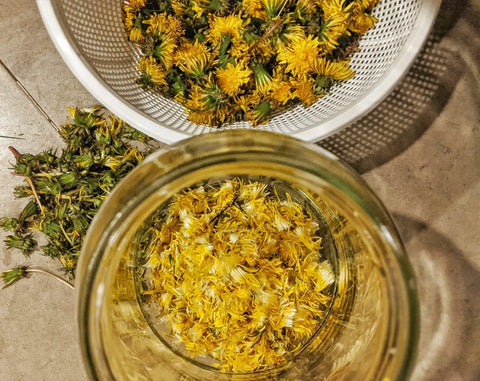
The leaves are best picked young and tender as they can be bitter, especially as they age. Heidi Merika in her book ‘Wildcraft’ suggests that Dandelion helps you with clearing away obstacles and letting go of that which is no longer serving you. ‘If you are weakened by indecision, it can bring you the clarity and the focus you need to move forward with purpose’. How to use it as a medicine? It can be used as an infusion (leaf), decoction (root), tincture (both root and leaf) or powder. This led us on a journey into wild foraged drinks concoction driven by inspiration to utilise as many of it’s medicinal forms as possible! (see our ‘Spirit of the Dandelion’ recipe below)
Part of our focus for this year has been helping people to rediscover lost knowledge and ancient wisdom, with the belief that this should exist more harmoniously with the innovation of the present day. Taking the best of the old and the new, to create a better now. There's a lineage of ancestral wisdom that we can all tap into, brought to the fore over the centuries by our species natural inclination towards wonder and discovery. Partaking on this journey towards nature and knowledge is one of re-empowerment and grounding and has so many health benefits - physiologically and psychologically.
If you feel this cocktail is too complex or too much work to take on from home, stay in touch for our upcoming drinks and food degustation events where we will be featuring cocktails such as these. You can also get in touch to book us for a special native, wild and foraged drinks degustation for an intimate party of up to 20 people (or as per the latest Covid guidelines). Join us on this journey, by signing up to our newsletter (scroll bottom of page) and staying up to date with all of our events - both in person, and online.
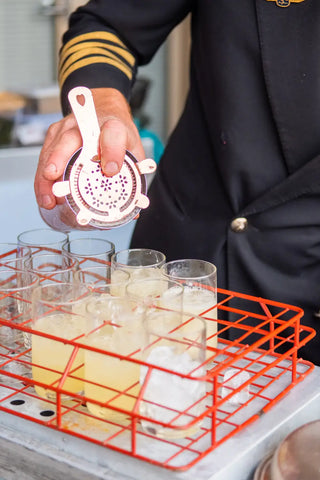
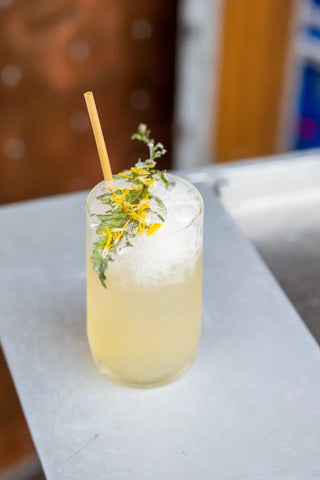
Spirit of the Dandelion Cocktail Recipe
by Byron Woolfrey
The Spirit of the Dandelion is the first of the cocktails that we served up at our first "Wild Feasts for a New Age" event. This event series began as a collaboration between Forage to Feast made up of renowned forager and environmental educator Diego Bonetto and stylish chef, designer, foodie and weed convert Marnee Fox, and the movers and shakers behind the sustainable drinks and events company Trolley'd. The local organic, wild foraged and native Australian cocktails (& mocktails) were designed by sustainable mixologist Byron Woolfrey and served at the aeronautically engineered Trolley'd bar.
30ml Dandelion Flower Infused White Rye 72%*
30ml Regal Rogue Lively White Vermouth
10 ml Dandelion Flower Syrup**
10 ml lemon juice
15 ml Roasted Dandelion Root Tea***
dash Dandelion & Burdock Bitters
Top with Roasted Dandelion Root Foam****
Garnish with crystallized dandelion leaf and fresh dandelion flowers
Method
Shake Rye, Vermouth, Dandelion Syrup, Lemon Juice & Dandelion Root Tea with ice.
Strain into rocks glass half filled with ice.
Top with Dandelion Root Foam.
Lay Crystallised dandelion leaf over rim of glass and sprinkle with fresh plucked dandelion petals.
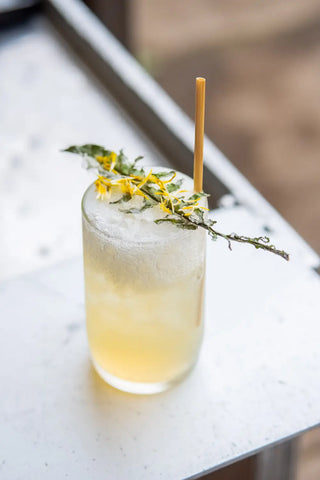
*Dandelion Flower Infused White Rye 72%
Pick fresh dandelions in the midday sun so as the nectar is ripe and the flowers are blossoming. Separate the yellow petals from the green bracts.
Combine 100g petals with 700ml of 72% White Rye (any overproof or navy strength white spirit can work), stick in a cool dark place for 3 weeks. To speed up this process you can put the petals and spirit into a sealed jar and thermo-regulate in a water bath for 2 hours at 51 degrees celsius.
Strain and bottle.
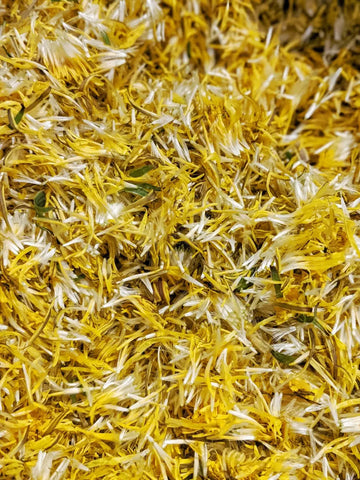
**Dandelion Flower Syrup
Ingredients:
4 cups dandelion petals
4 cups filtered water
3 lemon slices
1/2 vanilla bean
2 1/2 cups of granulated sugar
zest of 4 organic wax free lemons
Method:
Pick fresh dandelions in the midday sun so as the nectar is ripe and the flowers are blossoming. Separate the yellow petals from the green bracts.
Place the petals in a heavy saucepan with water, lemon slices and vanilla bean, bring to the boil then simmer for 30 minutes. Remove the pan from the heat and let steep for 6 hours.
Remove all of the pith from the lemon zest and combine with sugar.
Strain the dandelion petals from the water once finished steeping.
Remove zest from sugar leaving an oleo saccharum and spiced sugar.
Combine sugar with dandelion petal tea in a heavy based saucepan, bring to the boil then reduce to a simmer for 15 minutes.
Remove from heat and pour into sterilised jar or bottle.
Keep refrigerated, will last for 2-4 weeks.
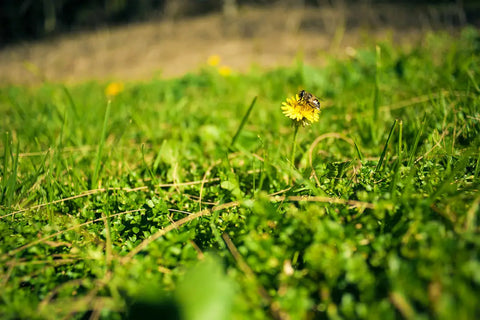
***Roast Dandelion Root Tea
When harvesting dandelions be sure to pull out the entire root system, this is easiest in Spring and Autumn with Autumn harvest having the highest levels of inulin for gut health. Recommend harvest 2 days after rain for ease of pulling roots.
Wash dandelion roots thoroughly then cut into 1cm pieces.
Slowly roast in oven until light golden brown.
Boil 2 litres of filtered water, add dandelion roots, turn of the heat and leave covered for 6-8 hours or overnight.
Store in the fridge for up to 2 days.
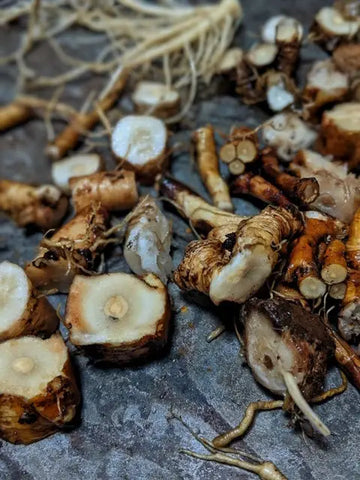
**** Roast Dandelion Root Foam
Blend 1 litre of Roasted Dandelion Root Tea with 8g (2 teaspoons) of Xantham & 8g of Soy Lecithin until thick.
Pour into whipped cream charger and charge with 2 Nitrous Oxide Bulbs.
Keep chilled for up to 2 days.
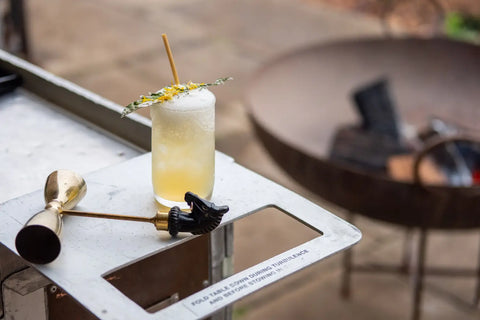
Dandelion Leaf Garnish
Harvest fresh young dandelion leaves, wash well and allow to dry.
Coat leaves in Aquafaba*
Dust leaves with icing sugar.
Dehydrate for 24 hours at 42 Degrees Celsius. (Alternatively stick in your oven after it has been turned off and leave overnight or on a dry warm window sill until dried out)
Store in an airtight container with a moisture absorber, I use an old teabag filled with rice.
*Aquafaba is the viscous water in which legume seeds such as chickpeas have been soaked or cooked. in this instance I soaked organic chickpeas for 8 hours in filtered water then strained off the water.
